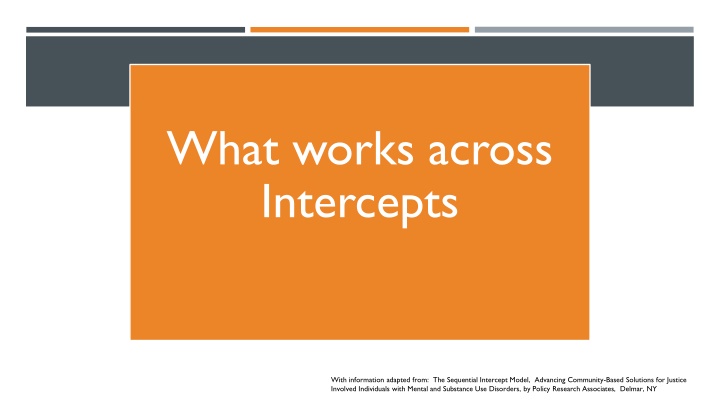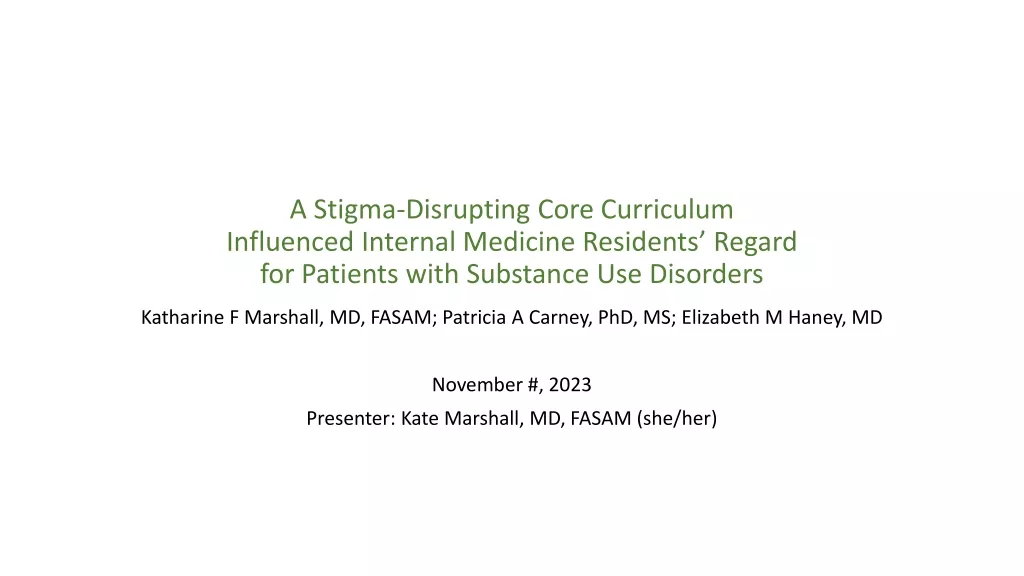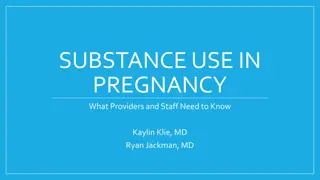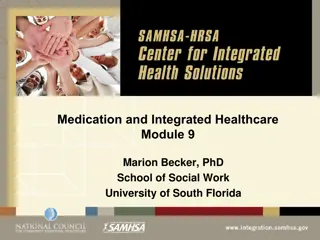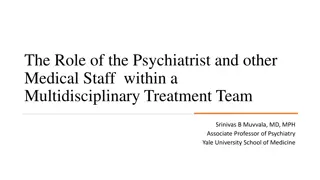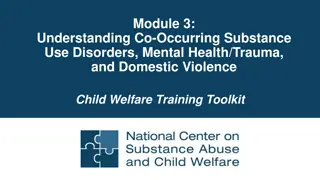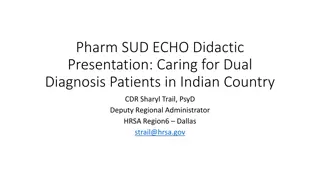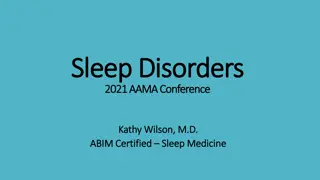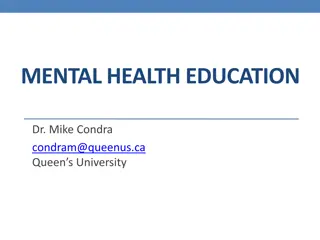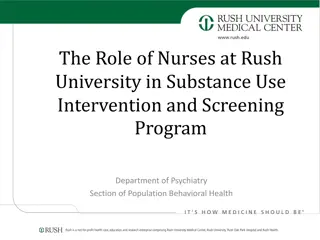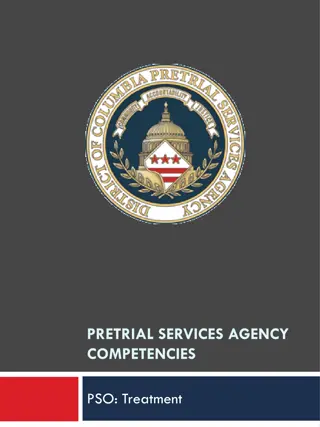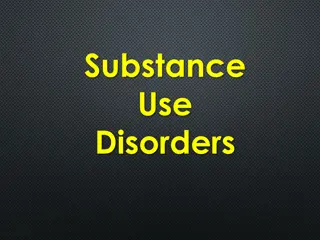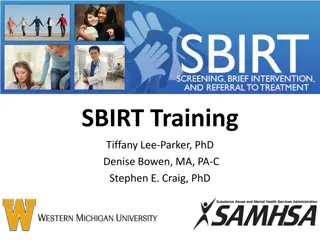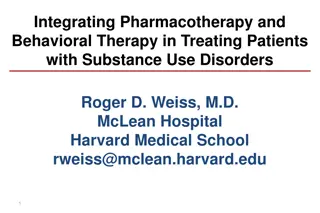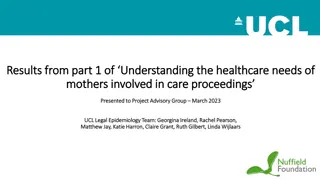Effective Strategies for Justice-Involved Individuals with Mental and Substance Use Disorders
The Sequential Intercept Model outlines various effective strategies at different intercept points to support individuals with mental and substance use disorders involved in the justice system. These strategies include cross-system collaboration, routine identification of individuals with disorders, linkage to beneficial services, vocational support, treatment planning, peer support, and more. Each intercept point emphasizes specific interventions such as crisis services, treatment and recovery, community engagement, and law enforcement training in behavioral health. Implementing these strategies can enhance outcomes and holistic support for this vulnerable population.
Download Presentation

Please find below an Image/Link to download the presentation.
The content on the website is provided AS IS for your information and personal use only. It may not be sold, licensed, or shared on other websites without obtaining consent from the author.If you encounter any issues during the download, it is possible that the publisher has removed the file from their server.
You are allowed to download the files provided on this website for personal or commercial use, subject to the condition that they are used lawfully. All files are the property of their respective owners.
The content on the website is provided AS IS for your information and personal use only. It may not be sold, licensed, or shared on other websites without obtaining consent from the author.
E N D
Presentation Transcript
What works across Intercepts With information adapted from: The Sequential Intercept Model, Advancing Community-Based Solutions for Justice Involved Individuals with Mental and Substance Use Disorders, by Policy Research Associates, Delmar, NY
ACROSS INTERCEPTS Cross-systems collaboration and coordination of initiatives. Routine identification of people with mental and substance use disorders. Linkage to benefits to support treatment success including Medicaid and Social Security. Information-sharing and performance measurement among behavioral health, criminal justice, and housing/ homelessness providers. identify high utilizers, provide an understanding of the population and its specific needs, and identify gaps in the system.
Vocational services Financial services Universal Assessment Warm hand offs/referrals Treatment Planning Behavioral Therapy Monitoring Case Management Pharmocotherapy Recovery & Peer Support Continuing care Housing/ transport Medical care Education and childcare services Legal services
What works at each Intercept
INTERCEPT -1: TREATMENT AND RECOVERY Universal screening/referral for MH and SUD in all possible settings Integrated behavioral healthcare models Comprehensive evidence-based treatment programs (i.e., MATRIX) Use of MAT when appropriate Continuum of care available to consumers as we have for chronic disease Focused efforts to assist high needs consumers known to the system Case management and connection to community-based services including housing, employment, benefits Professional peer support Recovery and social supports (AA, NA, MA, Phoenix)
INTERCEPT ZERO: COMMUNITY CRISIS SERVICES Maximize use of crisis lines and response teams (can be virtual) to divert and avoid transports Clear, consistent communication between crisis line, 911, LEA ED well connected to BH, with BH embedded if possible ED diversion with embedded mobile crisis personnel or peer specialist Connect with community services within 24-48 hours when leaving ED EMS trained in BH Peers involved in initial response, possibly in ED and after
INTERCEPT ONE: LAW ENFORCEMENT LEAs trained in BH and well connected to BH providers Co-Response Models BH and LEAs develop and refine response model, meet regularly Include a focus on reducing super-utilizers of 911 and ED Can involve peers Specialized Policing Teams Crisis Intervention Teams (CIT) Co-responder teams Follow-up teams and supports Dispatchers trained to recognize BH crisis and pass info along
INTERCEPT TWO: INITIAL DETENTION & COURT HEARINGS Regular communication among LEA, BH, courts Universal screening for MH and SUD and diversion to treatment when possible brief screens can be administered universally by non-clinical staff at jail booking, police holding cells, court lock ups, and prior to the first court appearance. divert Veterans to VA programs Risk-based pre-trial services and pre-adjudication drug treatment courts to reduce incarceration of those at low risk for criminal activity Courts more likely to divert if programs are in place
INTERCEPT THREE: JAILS AND COURTS Jails as HC settings need BH services and communication with BH providers National Commission on Correctional Healthcare can provide resources Jails can use crisis line to connect prisoners to assessment and counseling Connect inmates with benefits and meds before release Specialized Courts: Drug Treatment, Community, Mental Health and Co- occurring Courts Deferred prosecution for low level, low risk offenders
INTERCEPT FOUR: RE-ENTRY Transition planning by jail or in-reach providers: 30 days of medications, Rx in hand community-based treatment recovery support community-based services, including housing, employement Warm handoffs from jail to providers case managers or peers that transport individuals directly to services Assertive Community Treatment Teams (PACT) Intensive Case Management Programs
INTERCEPT FIVE: COMMUNITY CORRECTIONS Create specialized community supervision caseloads of people with behavioral health disorders. Promote use of Medication-assisted treatment when appropriate to reduce relapse episodes and overdoses among individuals returning from detention. As with Intercept 4, continue to increase access to recovery supports, benefits, housing, and employment. Create a Forensic PACT team to reduce recidivism with stronger engagement in community services.
QUESTIONS? POINTS FOR ACTION? 406-431-9260 | lovelandk@gmail.com
